TESLA MODEL S 2015 User Guide
Manufacturer: TESLA, Model Year: 2015, Model line: MODEL S, Model: TESLA MODEL S 2015Pages: 164, PDF Size: 4.78 MB
Page 11 of 164
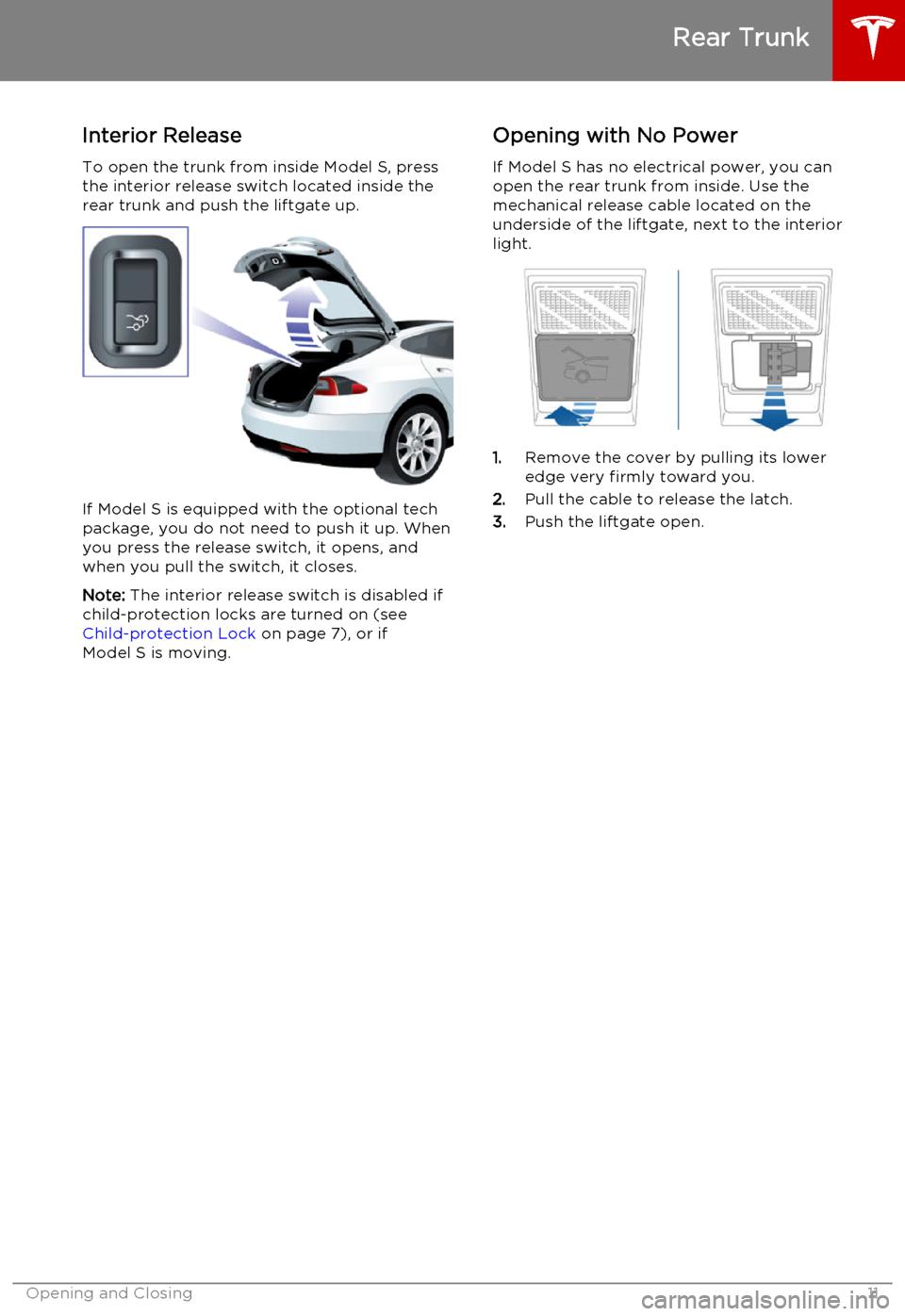
Interior ReleaseTo open the trunk from inside Model S, press
the interior release switch located inside the
rear trunk and push the liftgate up.
If Model S is equipped with the optional tech package, you do not need to push it up. When
you press the release switch, it opens, and
when you pull the switch, it closes.
Note: The interior release switch is disabled if
child-protection locks are turned on (see Child-protection Lock on page 7), or if
Model S is moving.
Opening with No Power
If Model S has no electrical power, you can
open the rear trunk from inside. Use the mechanical release cable located on the
underside of the liftgate, next to the interior
light.
1. Remove the cover by pulling its lower
edge very firmly toward you.
2. Pull the cable to release the latch.
3. Push the liftgate open.
Rear Trunk
Opening and Closing11
Page 12 of 164
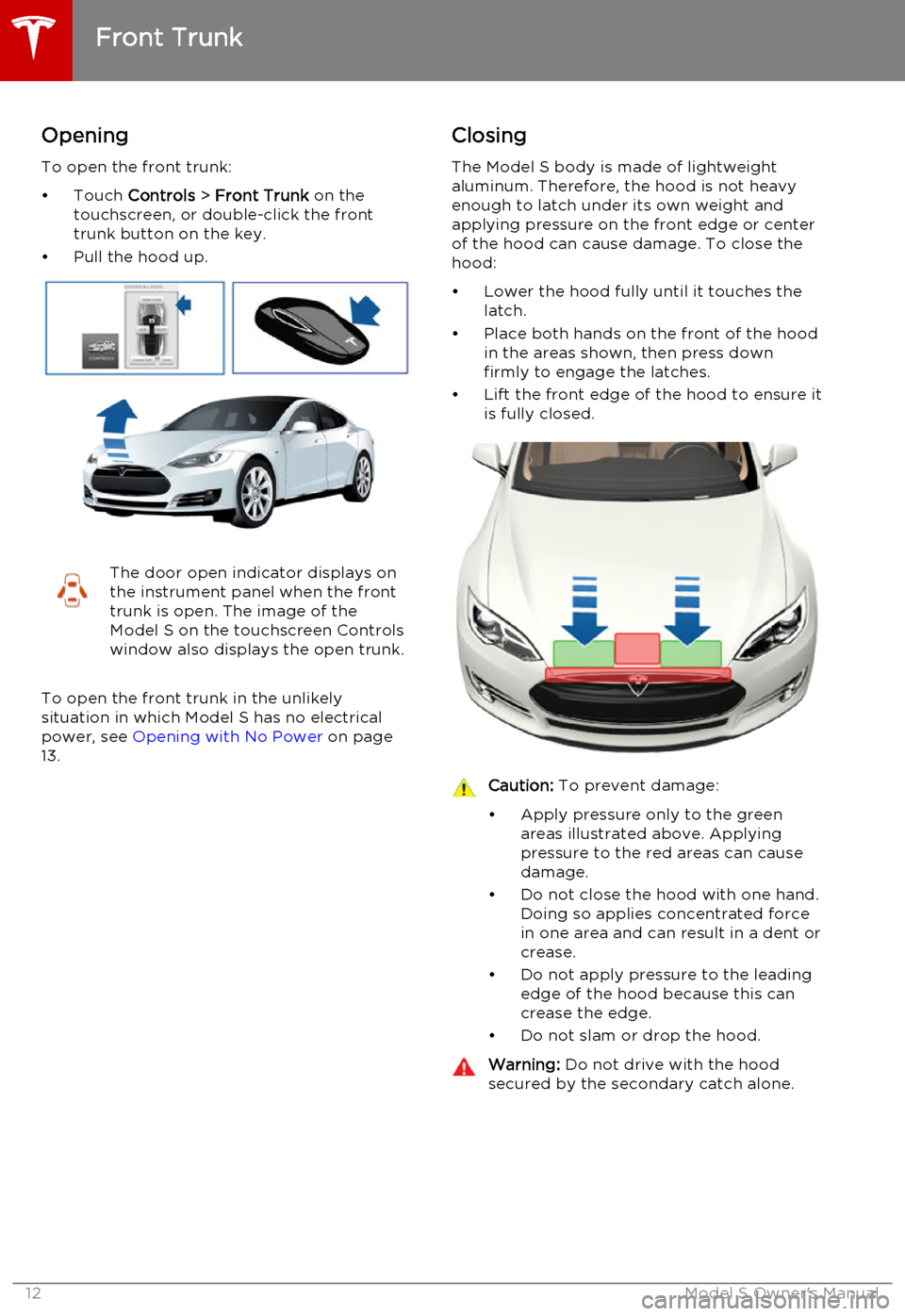
Opening
To open the front trunk:
• Touch Controls > Front Trunk on the
touchscreen, or double-click the front
trunk button on the key.
• Pull the hood up.The door open indicator displays on
the instrument panel when the front
trunk is open. The image of the
Model S on the touchscreen Controls
window also displays the open trunk.
To open the front trunk in the unlikely
situation in which Model S has no electrical
power, see Opening with No Power on page
13.
Closing
The Model S body is made of lightweightaluminum. Therefore, the hood is not heavy
enough to latch under its own weight and
applying pressure on the front edge or center
of the hood can cause damage. To close the hood:
• Lower the hood fully until it touches the latch.
• Place both hands on the front of the hood in the areas shown, then press down
firmly to engage the latches.
• Lift the front edge of the hood to ensure it is fully closed.Caution: To prevent damage:
• Apply pressure only to the green areas illustrated above. Applying
pressure to the red areas can cause
damage.
• Do not close the hood with one hand. Doing so applies concentrated force
in one area and can result in a dent or crease.
• Do not apply pressure to the leading edge of the hood because this can
crease the edge.
• Do not slam or drop the hood.Warning: Do not drive with the hood
secured by the secondary catch alone.
Front Trunk
12Model S Owner's Manual
Page 13 of 164
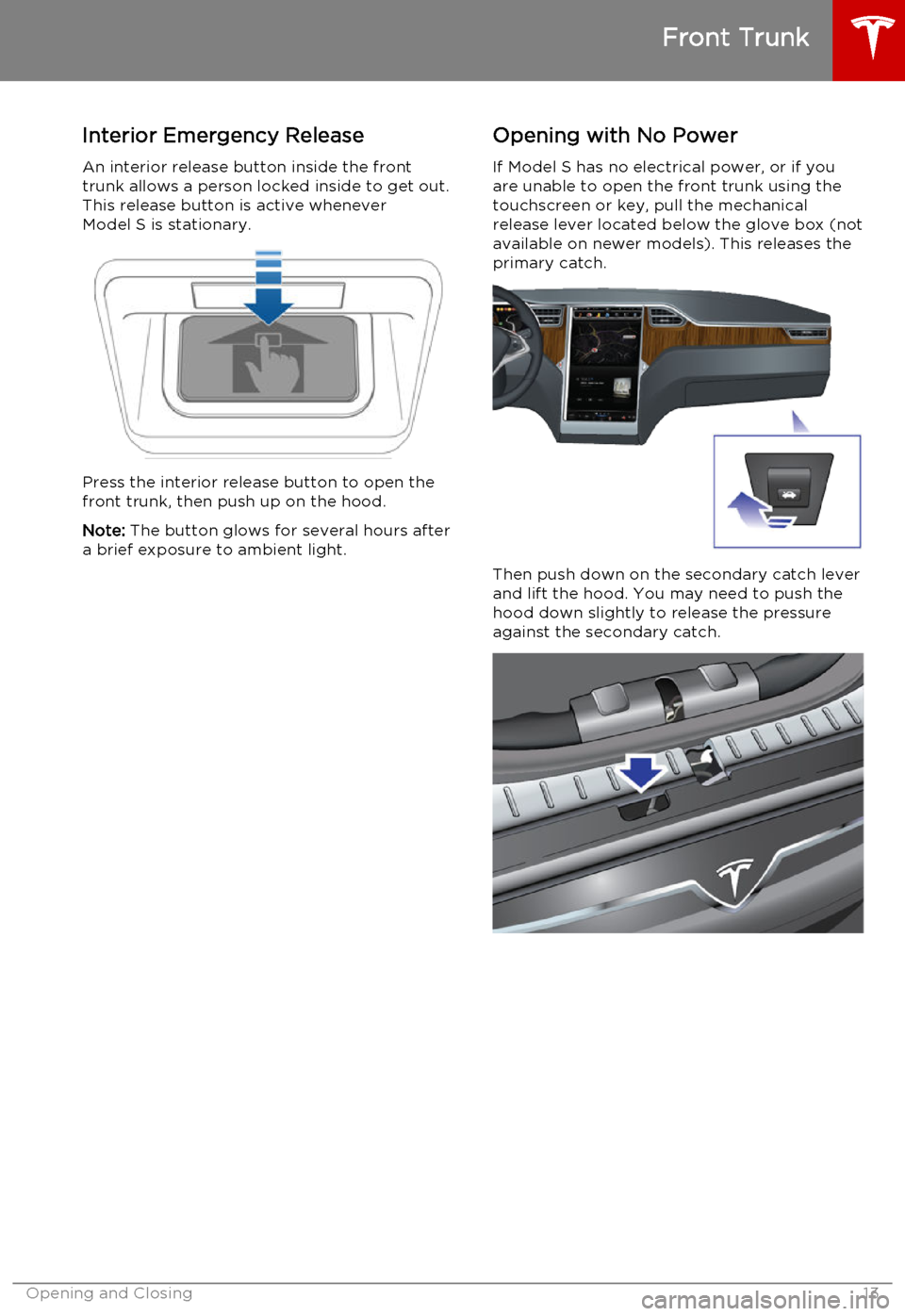
Interior Emergency Release
An interior release button inside the front
trunk allows a person locked inside to get out.
This release button is active whenever Model S is stationary.
Press the interior release button to open thefront trunk, then push up on the hood.
Note: The button glows for several hours after
a brief exposure to ambient light.
Opening with No Power
If Model S has no electrical power, or if you
are unable to open the front trunk using the
touchscreen or key, pull the mechanical
release lever located below the glove box (not
available on newer models). This releases the
primary catch.
Then push down on the secondary catch lever and lift the hood. You may need to push thehood down slightly to release the pressureagainst the secondary catch.
Front Trunk
Opening and Closing13
Page 14 of 164

Opening and Closing
To open the glove box, press the switch located on the side of the touchscreen. If you
leave the glove box open for five minutes, its
light automatically turns off.
Note: The glove box locks whenever Model S
is locked externally, using the key or walk- away locking. It does not lock when Model S is
locked using the touchscreen.
Warning: When driving, keep the glove
box closed to prevent injury to a
passenger if a collision or sudden stop
occurs.
Glove Box
14Model S Owner's Manual
Page 15 of 164
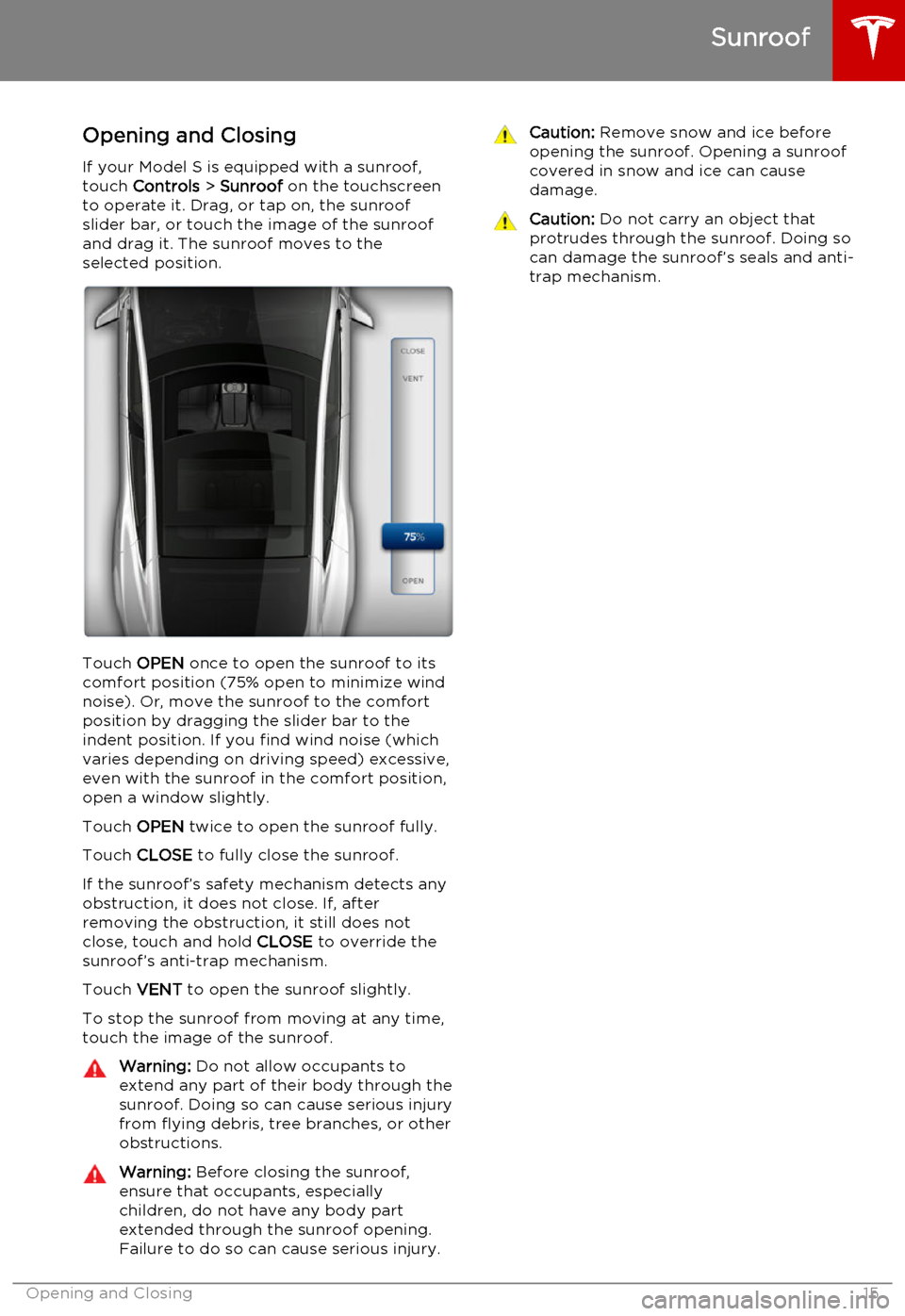
Opening and Closing
If your Model S is equipped with a sunroof, touch Controls > Sunroof on the touchscreen
to operate it. Drag, or tap on, the sunroof
slider bar, or touch the image of the sunroof
and drag it. The sunroof moves to the
selected position.
Touch OPEN once to open the sunroof to its
comfort position (75% open to minimize wind
noise). Or, move the sunroof to the comfort
position by dragging the slider bar to the indent position. If you find wind noise (which
varies depending on driving speed) excessive,
even with the sunroof in the comfort position, open a window slightly.
Touch OPEN twice to open the sunroof fully.
Touch CLOSE to fully close the sunroof.
If the sunroof’s safety mechanism detects any
obstruction, it does not close. If, after
removing the obstruction, it still does not close, touch and hold CLOSE to override the
sunroof’s anti-trap mechanism.
Touch VENT to open the sunroof slightly.
To stop the sunroof from moving at any time, touch the image of the sunroof.
Warning: Do not allow occupants to
extend any part of their body through the
sunroof. Doing so can cause serious injury from flying debris, tree branches, or other
obstructions.Warning: Before closing the sunroof,
ensure that occupants, especially
children, do not have any body part
extended through the sunroof opening.
Failure to do so can cause serious injury.Caution: Remove snow and ice before
opening the sunroof. Opening a sunroof
covered in snow and ice can cause
damage.Caution: Do not carry an object that
protrudes through the sunroof. Doing so can damage the sunroof’s seals and anti-trap mechanism.
Sunroof
Opening and Closing15
Page 16 of 164

Opening and Closing
To expose a cup holder, slide back the armrest.
Cup Holders
16Model S Owner's Manual
Page 17 of 164
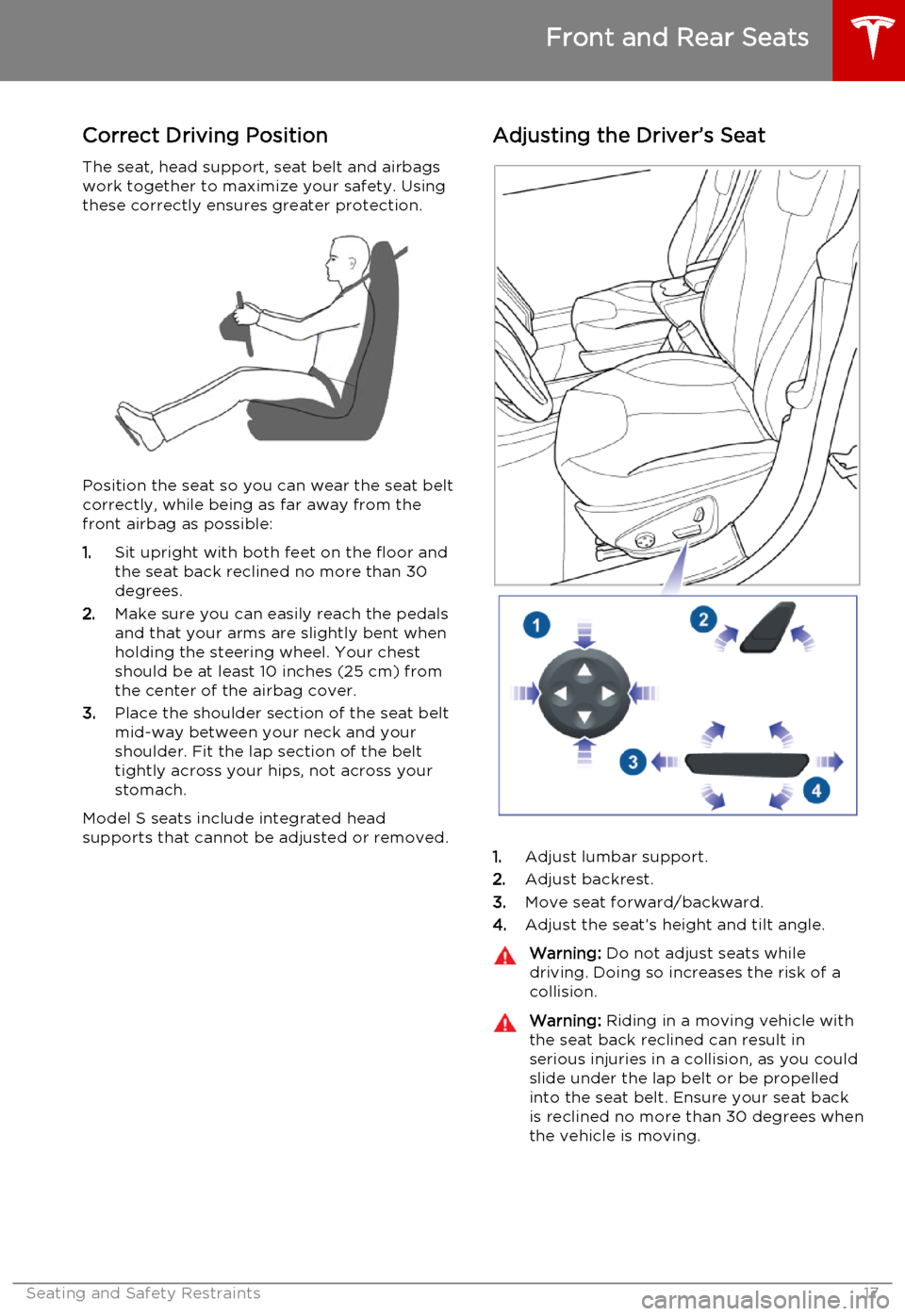
Correct Driving Position
The seat, head support, seat belt and airbags work together to maximize your safety. Using
these correctly ensures greater protection.
Position the seat so you can wear the seat belt
correctly, while being as far away from the
front airbag as possible:
1. Sit upright with both feet on the floor and
the seat back reclined no more than 30
degrees.
2. Make sure you can easily reach the pedals
and that your arms are slightly bent when
holding the steering wheel. Your chest
should be at least 10 inches (25 cm) from the center of the airbag cover.
3. Place the shoulder section of the seat belt
mid-way between your neck and your
shoulder. Fit the lap section of the belt
tightly across your hips, not across your stomach.
Model S seats include integrated head
supports that cannot be adjusted or removed.
Adjusting the Driver’s Seat
1. Adjust lumbar support.
2. Adjust backrest.
3. Move seat forward/backward.
4. Adjust the seat’s height and tilt angle.
Warning:
Do not adjust seats while
driving. Doing so increases the risk of a
collision.Warning: Riding in a moving vehicle with
the seat back reclined can result in serious injuries in a collision, as you could
slide under the lap belt or be propelled
into the seat belt. Ensure your seat back is reclined no more than 30 degrees when
the vehicle is moving.
Front and Rear Seats
Seating and Safety Restraints17
Page 18 of 164
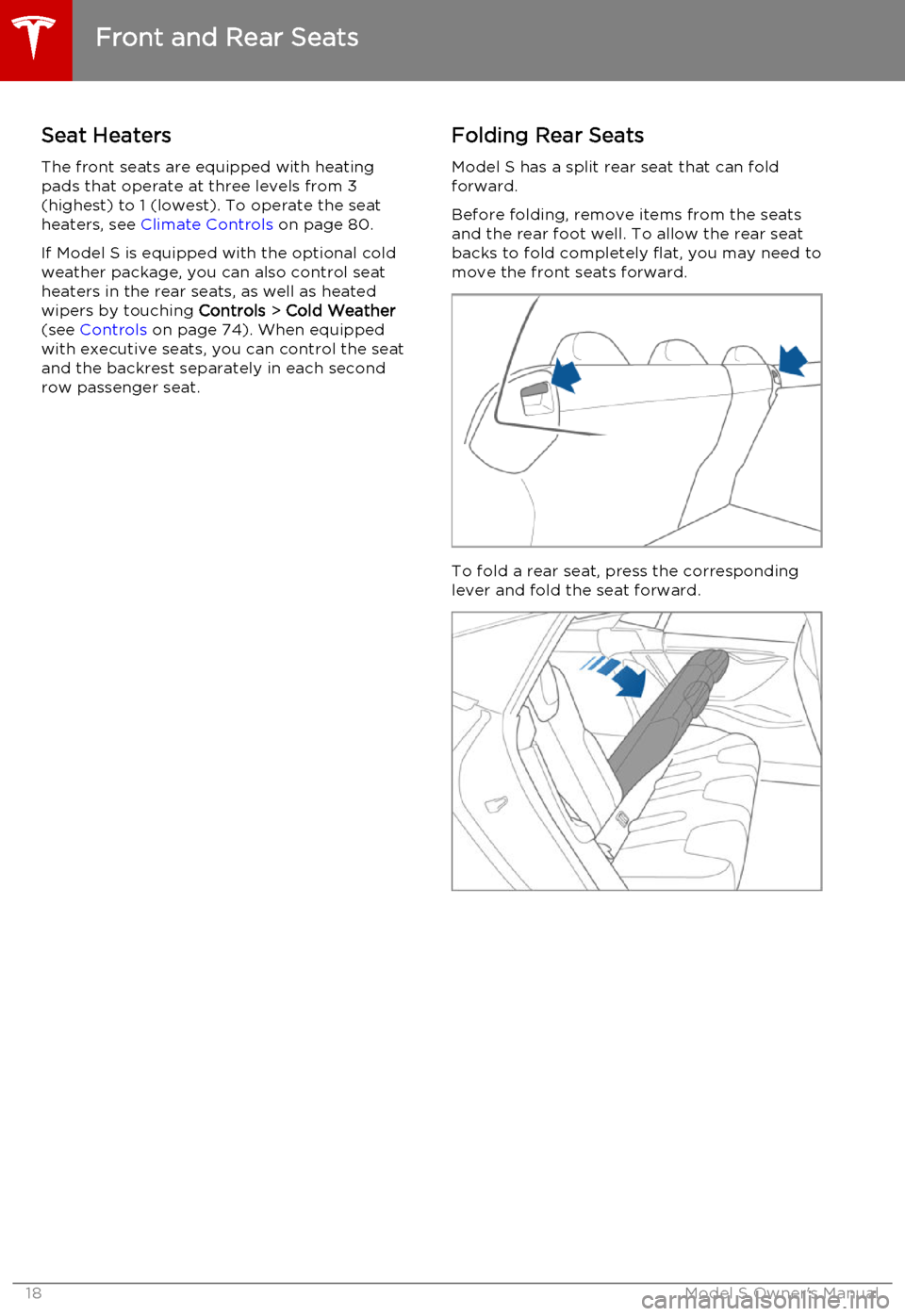
Seat Heaters
The front seats are equipped with heating pads that operate at three levels from 3
(highest) to 1 (lowest). To operate the seat
heaters, see Climate Controls on page 80.
If Model S is equipped with the optional cold
weather package, you can also control seat heaters in the rear seats, as well as heated
wipers by touching Controls > Cold Weather
(see Controls on page 74). When equipped
with executive seats, you can control the seat and the backrest separately in each second
row passenger seat.Folding Rear Seats
Model S has a split rear seat that can fold
forward.
Before folding, remove items from the seats and the rear foot well. To allow the rear seat
backs to fold completely flat, you may need to move the front seats forward.
To fold a rear seat, press the correspondinglever and fold the seat forward.
Front and Rear Seats
18Model S Owner's Manual
Page 19 of 164
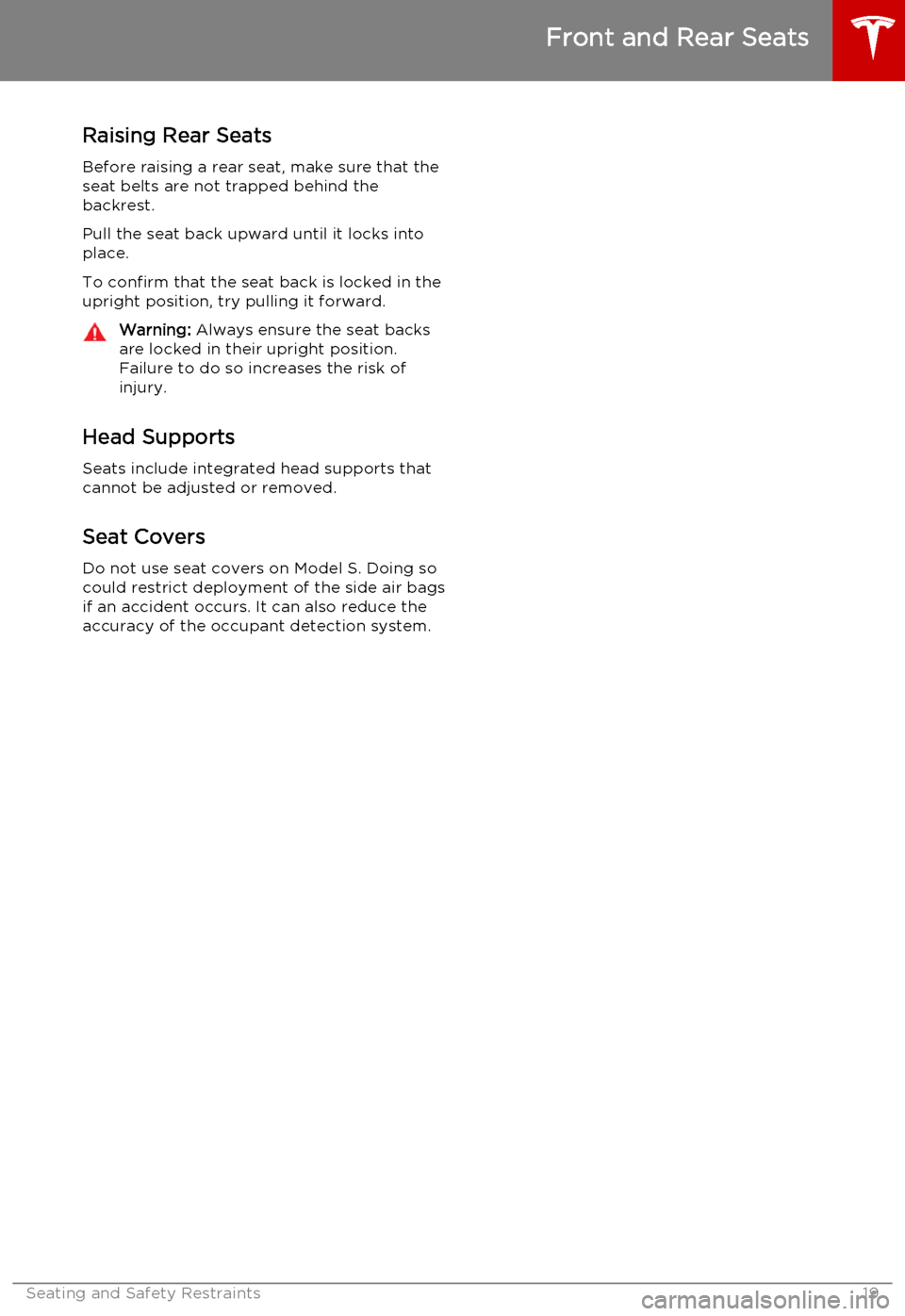
Raising Rear Seats
Before raising a rear seat, make sure that the
seat belts are not trapped behind the
backrest.
Pull the seat back upward until it locks into
place.
To confirm that the seat back is locked in the upright position, try pulling it forward.Warning: Always ensure the seat backs
are locked in their upright position.
Failure to do so increases the risk of
injury.
Head Supports
Seats include integrated head supports thatcannot be adjusted or removed.
Seat Covers
Do not use seat covers on Model S. Doing so could restrict deployment of the side air bagsif an accident occurs. It can also reduce theaccuracy of the occupant detection system.
Front and Rear Seats
Seating and Safety Restraints19
Page 20 of 164
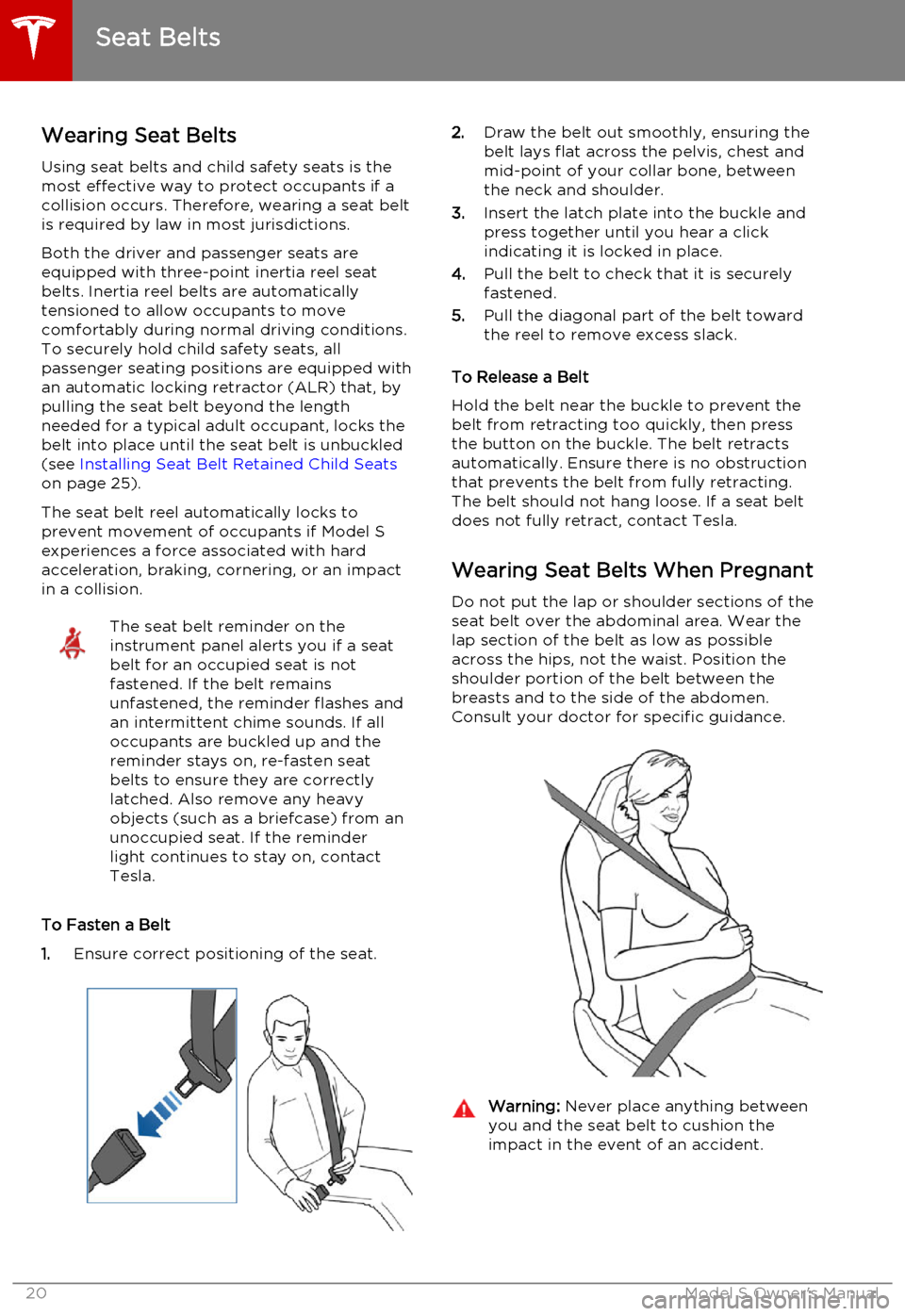
Wearing Seat Belts
Using seat belts and child safety seats is the most effective way to protect occupants if a
collision occurs. Therefore, wearing a seat belt
is required by law in most jurisdictions.
Both the driver and passenger seats are
equipped with three-point inertia reel seat
belts. Inertia reel belts are automatically
tensioned to allow occupants to move
comfortably during normal driving conditions.
To securely hold child safety seats, all
passenger seating positions are equipped with
an automatic locking retractor (ALR) that, by pulling the seat belt beyond the length
needed for a typical adult occupant, locks the
belt into place until the seat belt is unbuckled
(see Installing Seat Belt Retained Child Seats
on page 25).
The seat belt reel automatically locks to prevent movement of occupants if Model Sexperiences a force associated with hard
acceleration, braking, cornering, or an impact in a collision.The seat belt reminder on the
instrument panel alerts you if a seat
belt for an occupied seat is not
fastened. If the belt remains
unfastened, the reminder flashes and
an intermittent chime sounds. If all
occupants are buckled up and the
reminder stays on, re-fasten seat
belts to ensure they are correctly
latched. Also remove any heavy
objects (such as a briefcase) from an
unoccupied seat. If the reminder
light continues to stay on, contact
Tesla.
To Fasten a Belt
1. Ensure correct positioning of the seat.
2.
Draw the belt out smoothly, ensuring the
belt lays flat across the pelvis, chest and
mid-point of your collar bone, between
the neck and shoulder.
3. Insert the latch plate into the buckle and
press together until you hear a click indicating it is locked in place.
4. Pull the belt to check that it is securely
fastened.
5. Pull the diagonal part of the belt toward
the reel to remove excess slack.
To Release a Belt
Hold the belt near the buckle to prevent the
belt from retracting too quickly, then press
the button on the buckle. The belt retracts
automatically. Ensure there is no obstruction
that prevents the belt from fully retracting.
The belt should not hang loose. If a seat belt does not fully retract, contact Tesla.
Wearing Seat Belts When Pregnant Do not put the lap or shoulder sections of the
seat belt over the abdominal area. Wear the
lap section of the belt as low as possible across the hips, not the waist. Position theshoulder portion of the belt between thebreasts and to the side of the abdomen.
Consult your doctor for specific guidance.Warning: Never place anything between
you and the seat belt to cushion the
impact in the event of an accident.
Seat Belts
20Model S Owner's Manual